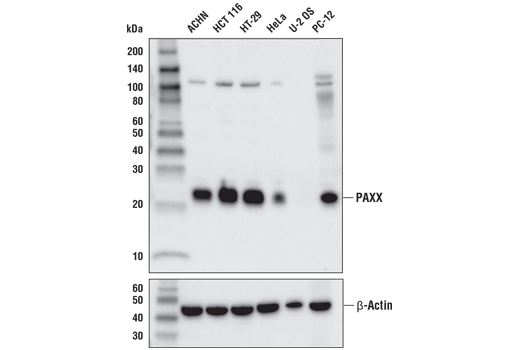WB, IP
H R
Endogenous
22
Rabbit IgG
#Q9BUH6
286257
Product Information
Product Usage Information
| Application | Dilution |
|---|---|
| Western Blotting | 1:1000 |
| Immunoprecipitation | 1:100 |
Storage
Specificity / Sensitivity
Species Reactivity:
Human, Rat
Source / Purification
Monoclonal antibody is produced by immunizing animals with a synthetic peptide corresponding to residues surrounding Pro195 of human PAXX protein.
Background
Double stranded DNA breaks (DSBs) are the most toxic of DNA lesions. They occur in response to genotoxic stress, and they are also an obligate intermediate in the V(D)J recombination events in the immune system. In mammalian cells, the most prominent mechanism by which cells deal with DSBs is known as NHEJ (non-homologous end-joining), and involves a core group of proteins that includes Ku, DNA-PK, XRCC4, and XLF (1).
PAXX, (PAralog of XRCC4 and XLF, also known as C9orf142 or XLS), is a more recently identified component of the NHEJ machinery whose crystal structure resembles that of XRCC4 (2). PAXX directly interacts with Ku, and promotes accumulation of Ku at DSBs (2,3). Depletion of PAXX impairs cellular DSB repair (2-4,5). Paxx -/- mice develop normally with mild radiosensitivity, but a Paxx/Xlf double knockout is embryonic lethal in mice, indicating synthetic lethality between Paxx and Xlf (6). Paxx/Xlf double knockout have increased apopotosis in post-mitotic motor neurons, as well as impaired development of the adaptive immune system (7).
- Tsai, C.J. et al. (2007) Proc Natl Acad Sci U S A 104, 7851-6.
- Ochi, T. et al. (2015) Science 347, 185-188.
- Liu, X. et al. (2017) Nat Commun 8, 13816.
- Craxton, A. et al. (2015) Cell Death Differ 22, 890-7.
- Xing, M. et al. (2015) Nat Commun 6, 6233.
- Balmus, G. et al. (2016) Genes Dev 30, 2152-2157.
- Abramowski, V. et al. (2017) Cell Death Differ , .
Species Reactivity
Species reactivity is determined by testing in at least one approved application (e.g., western blot).
Western Blot Buffer
IMPORTANT: For western blots, incubate membrane with diluted primary antibody in 5% w/v nonfat dry milk, 1X TBS, 0.1% Tween® 20 at 4°C with gentle shaking, overnight.
Applications Key
WB: Western Blotting IP: Immunoprecipitation
Cross-Reactivity Key
H: human M: mouse R: rat Hm: hamster Mk: monkey Vir: virus Mi: mink C: chicken Dm: D. melanogaster X: Xenopus Z: zebrafish B: bovine Dg: dog Pg: pig Sc: S. cerevisiae Ce: C. elegans Hr: horse GP: Guinea Pig Rab: rabbit All: all species expected
Trademarks and Patents
Limited Uses
Except as otherwise expressly agreed in a writing signed by a legally authorized representative of CST, the following terms apply to Products provided by CST, its affiliates or its distributors. Any Customer's terms and conditions that are in addition to, or different from, those contained herein, unless separately accepted in writing by a legally authorized representative of CST, are rejected and are of no force or effect.
Products are labeled with For Research Use Only or a similar labeling statement and have not been approved, cleared, or licensed by the FDA or other regulatory foreign or domestic entity, for any purpose. Customer shall not use any Product for any diagnostic or therapeutic purpose, or otherwise in any manner that conflicts with its labeling statement. Products sold or licensed by CST are provided for Customer as the end-user and solely for research and development uses. Any use of Product for diagnostic, prophylactic or therapeutic purposes, or any purchase of Product for resale (alone or as a component) or other commercial purpose, requires a separate license from CST. Customer shall (a) not sell, license, loan, donate or otherwise transfer or make available any Product to any third party, whether alone or in combination with other materials, or use the Products to manufacture any commercial products, (b) not copy, modify, reverse engineer, decompile, disassemble or otherwise attempt to discover the underlying structure or technology of the Products, or use the Products for the purpose of developing any products or services that would compete with CST products or services, (c) not alter or remove from the Products any trademarks, trade names, logos, patent or copyright notices or markings, (d) use the Products solely in accordance with CST Product Terms of Sale and any applicable documentation, and (e) comply with any license, terms of service or similar agreement with respect to any third party products or services used by Customer in connection with the Products.

